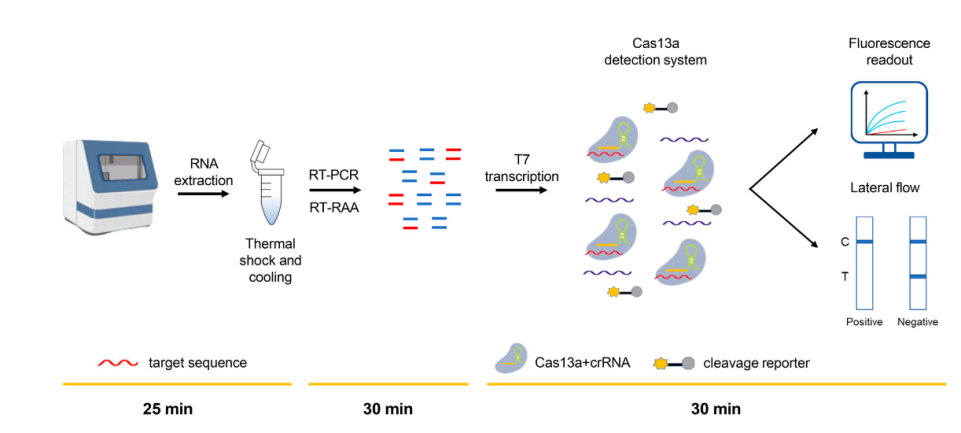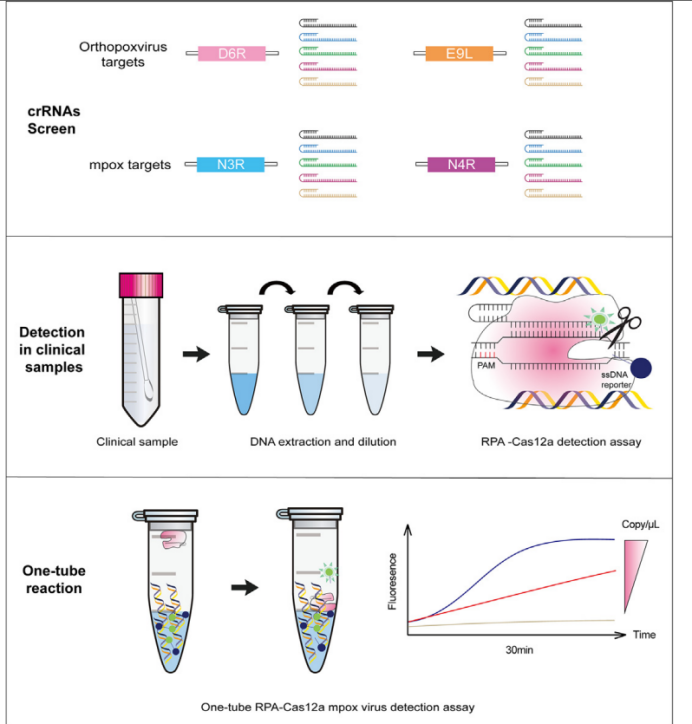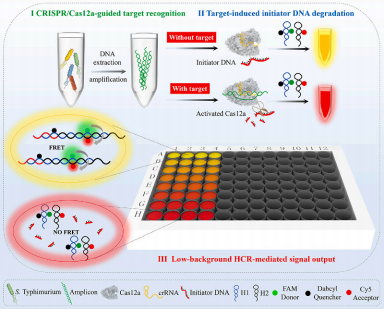[Research Frontier] New trends in CRISPR detection: Monkeypox virus detection
Compared to traditional detection methods, using CRISPR/Cas system as the testing method can avoid the potential risks and influence caused by high temperatures. More and more research are involved in CRISPR testing. Let us take a look at the latest research and development progress of CRISPR testing in this article.
CRISPR/Cas13a-Assisted accurate and portable hepatitis D virus RNA detection.
Hepatitis D virus (HDV) infection accelerates chronic hepatitis B virus (HBV) infection, bringing a huge burden to patients. Currently, there is still a lack of accurate and portable detection methods for HDV RNA. This article uses CRISPR-Cas13a technology to establish a convenient, rapid, highly sensitive and specific method to detect HDV RNA.
This paper conducted a cohort study of 144 HDV-IgG-positive patients to evaluate the diagnostic performance of CRISPR-Cas13a compared with RT-qPCR and digital PCR in identifying HDV in clinical samples.
For synthetic HDV RNA plasmids, the sensitivity of RT-PCR-CRISPR-based fluorescence detection is 1 copy/μL; for HDV RNA-positive samples, the sensitivity of RT-RAA-CRISPR-based fluorescence and lateral chromatography test paper assay is 10 copies /μL, like RT-qPCR and RT-ddPCR, the detection time is only about 85 minutes.
This high sensitivity and specificity, as well as a portable and simple CRISPR-based assay developed here for detecting HDV RNA, may be a prospective measure to monitor the development of HDV infection and evaluate the effectiveness of treatment.

Figure 1. Schematic diagram of HDV RNA testing based on CRISPR-Cas13a technology
If you also working on CRISPR Cas detection methods, EDITGENE provides all raw materials and outsourcing services for CRISPR-based detection, which is high sensitivity, short detection time and strong specificity.
Rapid and sensitive one-tube detection of mpox virus using RPA-coupled CRISPR-Cas12 assay.
Monkeypox is caused by a zoonotic virus belonging to the genus Orthopoxvirus and family Poxviridae. In this study, we developed a recombinant polymerase amplification (RPA)-coupled CRISPR-Cas12a assay for monkeypox virus. A series of CRISPR-derived RNAs (crRNAs) were designed and tested targeting the conserved D6R and E9L genes of orthopoxviruses and the specific N3R and N4R genes of monkeypox virus. D6R crRNA-1 showed the strongest activity in detecting orthopoxviruses, and N4R crRNA-2 was able to distinguish monkeypox virus from other orthopoxviruses. The detection limit of Cas12a/crRNA detection alone is 108 copies, while conjugation with RPA can increase the detection limit to 1-10 copies. Therefore, the single-tube RPA-Cas12a assay can detect as little as 1 copy of DNA virus in 30 minutes and is expected to provide point-of-care detection of monkeypox virus infection.

FIgure 2. RPA-Cas12a single tube detection
EDITGENE focuses on CRISPR detection technology and can provide all the above CRISPR raw materials in this study are in stock, and we have special discounts for CRISPR testing for new year promotion.
Rapid and sensitive one-tube detection of mpox virus using RPA-coupled CRISPR-Cas12 assay.
In conventional CRISPR-based biosensors, the signal induced by cleavage is insufficient because only one signal is generated during CRISPR-induced cleavage. Therefore, this paper developed a CRISPR/cas12a-based biosensor that expands signal generation and integrates hybridization chain reaction (HCR) and low-background resonance energy transfer (FRET) signal output modes. HCR with nucleic acid self-assembly ability is used as a signal carrier to load more signal molecules. To increase signal amplification, the fluorescence signal output modes (fluorescence recovery, FRET, and low-background FRET) generated by FAM and Cy5 were fully studied and compared. Under these conditions, the proposed method was successfully applied to the detection of Salmonella Typhimurium, and the detection lasted for 6 hours (including 4 hours of sample pretreatment) to the final detection result. Qualitative sensitivity dependent on color change is 103 CFU/mL. The biosensor has excellent detection performance, giving it great application potential in food and environmental safety monitoring.

FIgure 3. Detection of Salmonella Typhimurium using HCR and FRET based on CRISPR Cas12a biosensor
Contact Us
Email:info@editxor.com
Phone:833-2263234 (USA)

